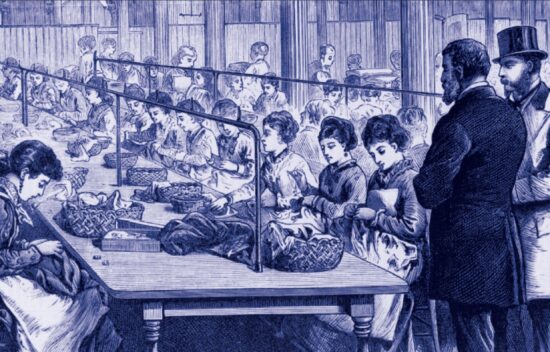
Shall Women Have the Right to Vote? (1866-1890)
75 min- Background Essay: Shall Women Have the Right to Vote?
- Handout A: Political Cartoon Analysis: “The Age of Brass” and “I wonder if it’s really becoming?”
- Handout B: Analyze a Cartoon Worksheet
- Handout C: A Movement Divided
- Handout D: Is it a Crime for a Citizen of the United States to Vote?
- Handout E: Suffrage by State
- Handout F: Women’s Political Voices
- Appendix A: Amending the Constitution
- Appendix B: Timeline and Quotes
- Appendix C: Timeline Cards
- Appendix G: A Pathway for Change
- Cult of Domesticity
- republicanism
- National Woman Suffrage Association
- American Woman Suffrage Association
FOR FURTHER READING
- Baker, Jean. Sisters: The Lives of America’s Suffragists (2006)
- Flexner, Eleanor, Mary Wollstonecraft: A Biography, Coward, McCann, & Geoghegan, Inc. (1972)
- Flexner, Eleanor and Ellen Fitzpatrick, Century of Struggle: The Women’s Rights Movement in the United States, Belknap Press (1996)
- Project, hand out, or post in the room copies of the pair of political cartoons: Handout A: Political Cartoon Analysis: “The Age of Brass” and “I wonder if it’s really becoming?”
- Have students work in small groups of at least four. Subdivide the groups and give half of each small group one of the cartoons along with Handout B: Analyze a Cartoon Worksheet. Ask students to examine their assigned cartoon closely, complete Handout B: Analyze a Cartoon Worksheet for each of the cartoons, and then compare the two cartoons within their groups.
- Reconvene the whole class and discuss the following questions:
- What are some of the obstacles that suffragists faced?
- How does the movement for women’s suffrage embody the principles of equality, consent of the governed, and representative government?
- How are those principles portrayed differently in the two cartoons?
- In what ways are the cartoons alike?
- You may wish to clarify some of the terminology in the cartoons. For example, focusing on the titles of the cartoons, one meaning of “brass” is impertinence, audacity, shamelessness. Also, students may not be familiar with the use of “becoming” to mean “attractive.”
Activity 1 » 15 minutes
- Distribute Handout C: A Movement Divided and have students complete the table using their Background Essays as a reference.
- Ask for volunteers to share their responses to the review questions from Background Essay, and discuss as a large group.
Activity 2 » 15 minutes
- Have students analyze Susan B. Anthony’s speech justifying her decision to vote illegally. Working in pairs or trios, students should complete Handout D: Is it a Crime for a Citizen of the United States to Vote?
- Discuss the answers as a large group.
- Discuss with students the concept of historical thinking. For example: Have students make a T-chart on their paper and quickly list some advantages and disadvantages of the instant communication technology available to them today. On a second T-chart, have them list advantages and disadvantages that people might have experienced before the communication and transportation technologies that emerged after 1900. Lead a discussion of questions such as:
- Does it seem unusual to us that Susan B. Anthony would travel around her county in the Rochester, New York, area giving speeches? To what extent is a speaking tour important for influential leaders today? What other options for informing the public and generating support are available today?
- What is the difference between reading a short tweet on our phones and seeing/hearing someone deliver a speech in person? What are some things you experience with the latter that you cannot with the former?
- How is generating support for a reform movement different today than it may have been in the post-Civil War period?
- How can easy access to technology benefit individuals and groups in their political rights and responsibilities?
- To what extent might easy access to technology cause us to take our political rights and responsibilities for granted?
- Use Appendix G: A Pathway for Change to determine where in the pathway the women’s movement seems to be by 1890.
- Have students use Appendix B: Timeline and Quotes for reference while they label and shade in Wyoming, Utah, Washington, and Montana on Handout E: Suffrage by State. (Note: The map will be used again in the next lesson.)
A. As a class, brainstorm significant accomplishments of women in U.S. history prior to 1890. Note: You can do this activity even if you have not done the previous lessons in this curriculum. Students can use other books, online sources, and outside knowledge to fill in the information. Distribute Handout F: Women’s Political Voices and have students select two to three additional people/accomplishments to fill in the chart. Have them complete the chart for homework, and then lead students in a discussion of ways that the rights protected in the Constitution and Bill of Rights empower all individuals to persuade their fellow citizens of their views.
B. Play an audio version or have students read the entire speech, “Is it a Crime for a Citizen of the United States to Vote?” Anthony’s speech is available at “Civil Rights and Conflict in the United States: Selected Speeches by FCIT;” Florida Center for Instructional Technology, College of Education, University of South Florida. Students should write a brief reflection in response explaining which of Anthony’s constitutional arguments they believe was the strongest and why.
C. Have students draw their own pro-suffrage and/or anti-suffrage cartoons.





